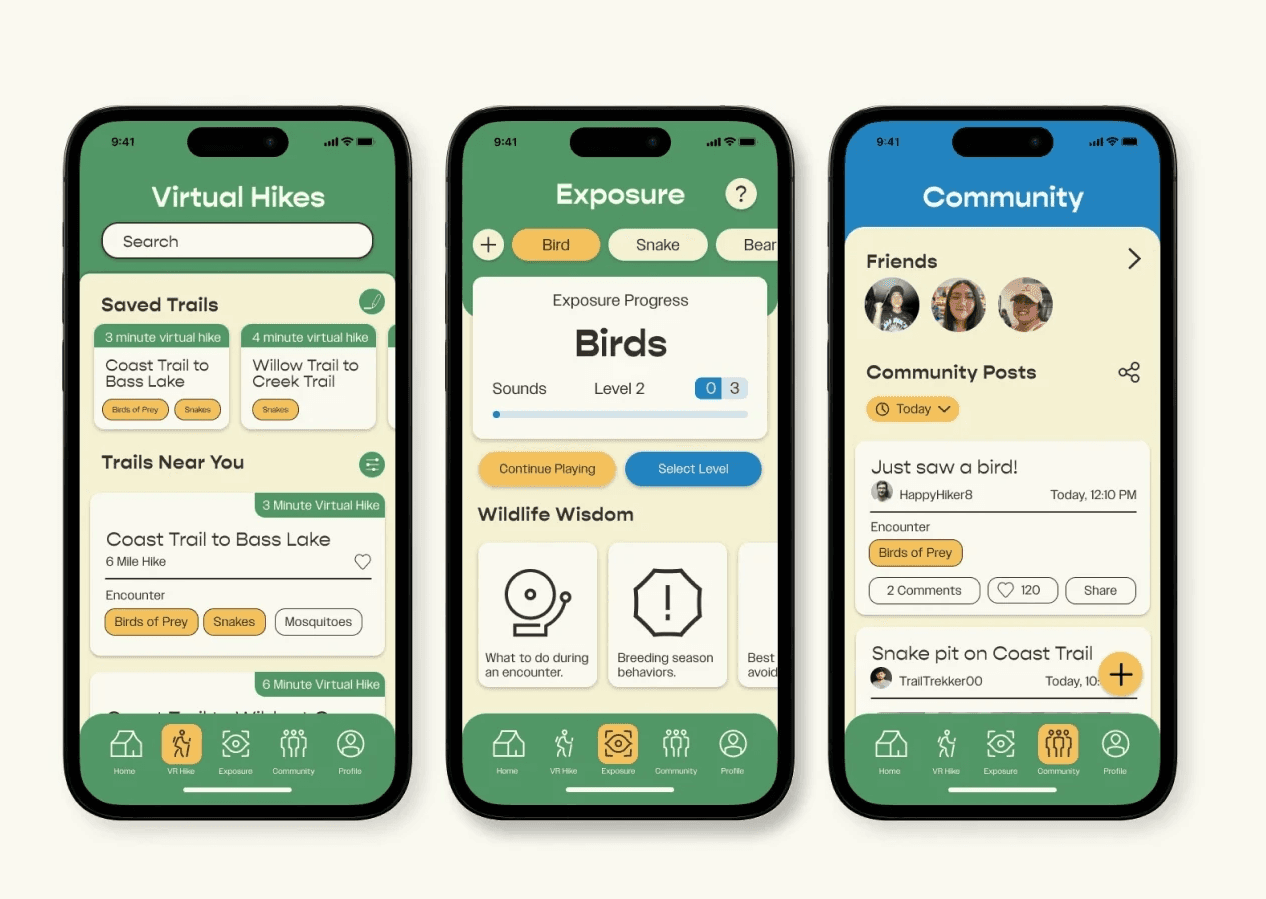WildWise
Break Free from Phobias, Embrace the Wild
This Project I was Tasked to
Create an app to address a modern fear.
Timeline
9 weeks
Team
3 people
Software
Figma
Role
Designer
Skills
UXR & UX Design
Project Overview
Problem
People with animal phobias don't know where to start with overcoming and managing their phobia(s)
Exposure therapy, a main form of treatment for phobias, is often too expensive and not covered by insurance. Without easy access to resources it can be hard to know how to overcome an animal phobia.
core question
How might we support people with animal phobias to get exposure therapy while encouraging them to explore outdoors?
Goals
Provide an accessible form of exposure therapy for a variety of animals
Give users a community space to discuss their phobias and animal sightings with others
Encourage users to go outdoors and face their fears while providing them information about animal sightings
Solution
Providing a low-tech exposure therapy game and a space for people with phobias to socialize and share their experiences.
My Role
Research, Branding, Design, Prototyping, UX Strategy
User Guided Research
Animal Phobia Research
Starting with secondary research, I came across a case study about using augmented reality to treat small animal phobias that had an alarming statistic:
60-80% of phobia sufferers do not seek treatment, and after understanding the procedure 25% of potential patients refuse to participate in exposure therapy.
From additional research we learned that:
12% of adults in the US have an animal phobia
People in urban areas tend to have more fears than those in rural areas
Fears often come from childhood experiences
Most common treatment is exposure therapy, but it's not covered by insurance and the cost makes it inaccessible.
Learning as as much as we could about animal phobias, we set out to create a fun and approachable way for people to overcome their animal phobias.
User Interviews
As a group, we interviewed six people with different types of animal phobias and phobia severities. We learned that that their phobias came from poor past experiences with the animal or from media influence at a young age. We found a shocking theme across all our interviews:
Interviewees felt that they had no way to prepare or anticipate an animal encounter. Feeling that it was often impossible to avoid an encounter or prepare for one.
Design Process
Concept Proposal
Our concept proposal gave us our final strategic direction for our project, highlighting three phases we want our users to go through with their phobias.
Product Map
To understand how our app would work on a technical level and how our users might think while using our app, we created a product map of the entire user experience on the app.
Storyboards
Wireframes
Paper Prototyping
We took our lo-fi screens and made a paper prototype video with them to better understand and develop the user-experience of our app. It helped us refine the main game and community sections for the app.
Main Features
Exposure game providing 6 levels of different animal concepts to gradually introduce them to the user. Wildlife wisdom provides information about specific animals, like their different behaviors and how to avoid them.
Virtual AR hikes, inspired by Google Street View, where hikers can see nearby trails and what animals have been reported on the trail. When hikers physically go on trails they're able to get live updates about animal sightings and hotspots.
Community provides a place for hikers to share their experiences, stories, encounters, photos and tips to help others.
Through these features, our app addresses the three states of animal encounters: before, during and after.
Final Features
An app that turns animal phobia exposure therapy into outdoor fun, inspiring users to get active. Covering three stages of animal encounters: before, during, and after.
Exposure Game
Helps players become more comfortable with specific animals.
Gradually exposes players to the animals over six levels.
Shows players variety within the animal group.
Virtual Hikes
Informs hikers of nearby trails and hikes.
Prepares hikers by showing what animals are active and have been reported on the trail
Notification alerts when approaching an animal hotspot area.
Community
Provides a place for hikers to share their experiences.
Hikers can share stories, encounters, photos, and tips to help others.
Allows hikers to reflect on their experiences.
Final Screens
Exposure Game
6 Distinct Levels: Terms, Sounds, Symbols, Images, Videos, and a Petting minigame.
Lessons Learned
This was my first app I created from scratch, from conceptualization to prototyping. I learned that I'm overeager about features that I want to add into my projects. My imagination was too big for the timeframe and scope of this project, but I learned to channel it to develop different details in our app.
Learnings:
Exploring different concepts to enhance your main features/focus of the app.
You can never understand users enough. We gained a lot of good insight into what people would really be looking for in a phobia app. We never got to test our game with people who have animal phobias due to the time constraint and I would do testing in my next app.
Remember the user's needs. We had a lot of concepts we wanted to incorporate initially. The app grew out of the scope we had for the timeframe and it started becoming a general hiking safety app. We were forgetting about our users.
Making an app fast. We spent the majority of time on this project researching and developing concepts for the user experience within our product. We only had two weeks to visually design everything and were new to prototyping in Figma.
Next time I would change the AR/map feature to only show areas of animal activity as pins in the map and areas of hotspots on the map. As well as having hiking specific views for the map.
















